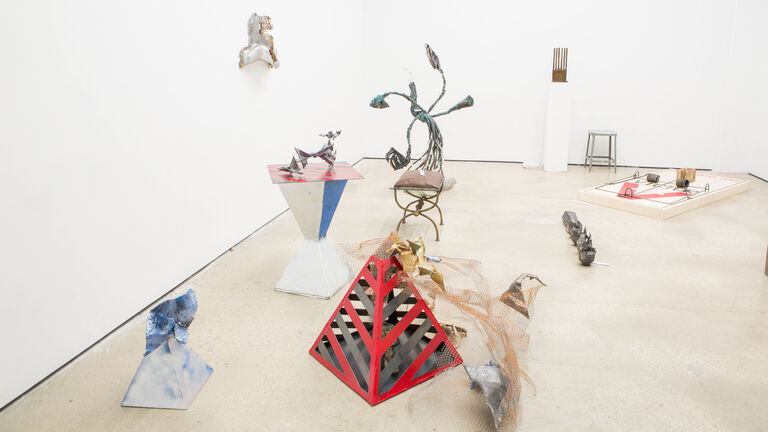
Undergraduate Overview
Undergraduate Overview
Spring 2026 Application Deadline: December 15
Fall 2026 Early Action & Priority Merit Scholarship Deadline: December 15
SAIC’s undergraduate sculpture curriculum is designed to offer a rigorous mix of conceptual, spatial, material, and process-based challenges through which students learn to understand, negotiate, and contribute to the changing cultural landscape. Students explore and incorporate a wide range of emerging technologies and traditional skills in their practice, including:
- Woodworking
- Mold-Making and Casting
- Foundry
- Glass Casting
- Welding and Blacksmithing
- Installation Art
- Socially Engaged Art
- Experimental Media
- Sustainable Practices
BFA students interested in Sculpture are encouraged to combine their sculptural work with departments across the school including fiber, ceramics, designed objects, fashion, and more. Introductory sculpture courses are recommended for all entering students, as they provide an introduction to the field, its methodologies and current ideas. Students who choose to concentrate their undergraduate in Sculpture will move from introductory, to intermediate and then advanced studio courses. We also offer a number of undergraduate seminars in Sculpture from Sophomore Seminar to Professional Practices and finally our Senior Capstone. The department also offers a unique opportunity for accomplished and committed undergraduate students in our Advanced Sculptural Practices Studio. This application-based course offers studio space in which to work and learn in close consultation with two faculty instructors and in a small community of dedicated peers.
Sculpture BFA Learning Goals
- Students will create sculptural works that demonstrate a broad-based awareness of the field.
- Students will learn to experiment in order to gain knowledge and acquire technical proficiency.
- Students will engage material and process towards an outcome.
- Students will develop an appreciation of the complexity of sculptural meaning.
- Students will formulate, present and defend their ideas towards an independent criticality.
Undergraduate Admissions Requirements & Curriculum Overview
-
To apply to the School of the Art Institute of Chicago (SAIC), you will need to fill out an application and submit your transcripts, artist's statement, and letters of recommendation. And most importantly, we require a portfolio of your best and most recent work—work that will give us a sense of you, your interests, and your willingness to explore, experiment, and think beyond technical art, design, and writing skills.
In order to apply, please submit the following items:
Bachelor of Fine Arts in Studio Portfolio
Submit 10–15 pieces of your best and most recent work. We will review your portfolio and application materials for merit scholarship once you have been admitted to SAIC.
When compiling a portfolio, you may concentrate your work in a single discipline or show work in a breadth of media. The portfolio may include drawings, prints, photographs, paintings, film, video, audio recordings, sculpture, ceramics, fashion designs, graphic design, furniture, objects, architectural designs, websites, video games, sketchbooks, scripts, storyboards, screenplays, zines, or any combination of the above.
Learn more about applying to SAIC's Bachelor of Fine Arts in Studio, or view our portfolio preparation guide for more information.
-
Studio 69 - CP 1010 Core Studio Practice I (3)
- CP 1011 Core Studio Practice II (3)
- CP 1020 Research Studio I (3)
- CP 1022 Research Studio II (3)
- SOPHSEM 2900 (3)
- PROFPRAC 39XX (3)
- CAPSTONE 49XX (3)
- Studio Electives (48)
Art History 15 - ARTHI 1001 World Cultures/Civilizations: Pre-History—19th Century Art and Architecture (3)
- Additional Art History Course at 1000-level (e.g., ARTHI 1002) (3)
- Art History Electives at 2000-, 3000-, or 4000-level (9)
Liberal Arts 30 - ENGLISH 1001 First Year Seminar I (3)
- ENGLISH 1005 First Year Seminar II (3)
- Natural Science (6)
- Social Science (6)
- Humanities (6)
- Liberal Arts Electives (6)
- Any of the above Liberal Arts or certain AAP or EIS
General Electives 6 - Studio, Art History, Liberal Arts, AAP, or EIS
Total Credit Hours 120 * BFA students must complete at least two classes designated as "off campus study." These classes can also fulfill any of the requirements listed above and be from any of the divisions (Art History, Studio, Liberal Arts, or General Electives).
BFA in Studio with Thesis Option (Liberal Arts or Visual Critical Studies): Students interested in pursuing the BFA in Studio with the Thesis Option (Liberal Arts or Visual Critical Studies) should contact their academic advisor for details about eligibility, program requirements, and the application process.
Total credits required for minimum residency
66
Minimum Studio credit
42
Course Listing
Upcoming Admissions Events
Meet with us, learn more about SAIC and our curriculum, and get feedback on your work. LEARN MORE.
Get More Info
Sign up for email updates to learn more about our undergraduate programs.